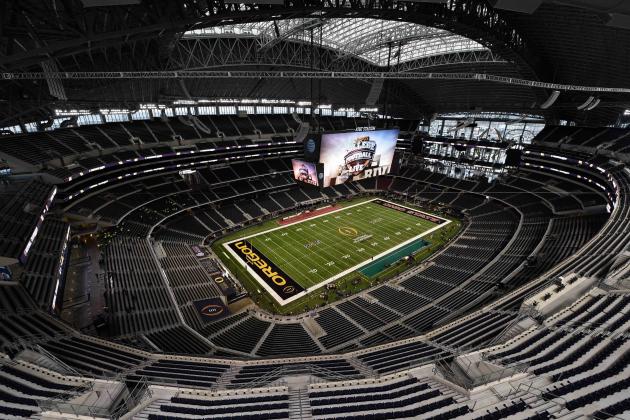AT&T Stadium originally estimated to cost $650 million, the stadium's current construction cost was $1.15 billion,making it one of the most expensive sports venues ever built. To aid Cowboys owner and general manager Jerry Jones in paying the construction costs of the new stadium, Arlington voters approved the increase of the city's sales tax by 0.5%, the hotel occupancy tax by 2%, and car rental tax by 5%. The City of Arlington provided over $325 million (including interest) in bonds as funding,and Jones covered any cost overruns. Also, the NFL provided the Cowboys with an additional $150 million loan, following its policy for facilitating financing for the construction of new stadiums.
A pair of nearly 300 ft (91 m)-tall arches spans the length of the stadium dome, anchored to the ground at each end. The new stadium also includes "more than 3,000 Sony LCD displays throughout the luxury suites, concourses, concession areas and more, offering fans viewing options that extend beyond the action on the field". It also houses a center-hung video display board that was the largest high-definition television screen in the world at the time of their installation. It has since been surpassed in size by the video board at Texas Motor Speedway. Glass doors, allowing each end zone to be opened, were designed and constructed by Dallas-based Haley-Greer glass systems.
The retractable roof was designed by structural engineering firm Walter P Moore and the systems were implemented by mechanization consultants Uni-Systems. The electrification of Cowboys Stadium's retractable roof was developed by VAHLE, Inc. These Kinetic Architecture fundamentals will be employed in order to create quick conversions of the facility to accommodate a variety of events. When the design was officially unveiled on December 12, 2006, it showed that, from inside the stadium, the roof (membrane installed by K Post Company of Dallas) will look very similar to the Texas Stadium roof, with its trademark hole. However, it can be covered by the retractable roof panel to protect against the elements.
A Dallas Cowboys Hall of Fame is planned for the Hall of Fame level. The drawings also include a site for a large sculpture northeast of the stadium, close to Randol Mill Road.
Mayor Robert Cluck claimed to use eminent domain as a last resort but most of the properties refused to sell to the city, indicating that the incentive program was not adequate according to Glenn Sodd, an attorney representing some home owners in the area. Attorney Bob Cohen, who is representing some of the property owners, said the city gave many of his clients little incentive to sell. He said he represents the owners of some rental properties who were counting on that monthly revenue for their retirement and said most homeowners cannot afford to re-build or buy in that area with the incentive package.
